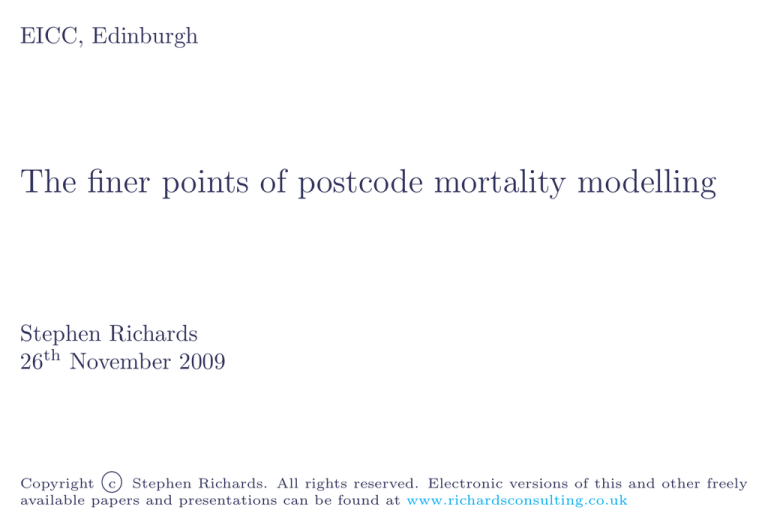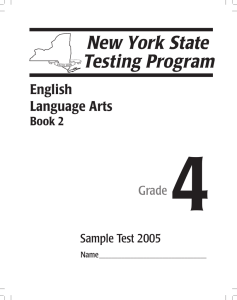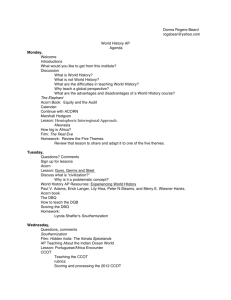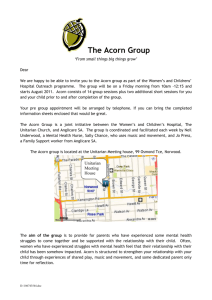
EICC, Edinburgh
The finer points of postcode mortality modelling
Stephen Richards
26th November 2009
Copyright c Stephen Richards. All rights reserved. Electronic versions of this and other freely
available papers and presentations can be found at www.richardsconsulting.co.uk
Plan of talk
1. Postcode anatomy
2. Geodemographics
3. Comparing geodemographic profilers
4. Enhancing geodemographic profilers
5. Conclusions
Slide 1
www.richardsconsulting.co.uk
1. Postcode anatomy
Slide 2
www.richardsconsulting.co.uk
1. Hierarchical structure of a UK postcode
Slide 3
www.richardsconsulting.co.uk
1. Postcode modelling options — geographical
Postcode
element Example
Region
District
Sector
EH
EH11
EH11 2
Count
121
2,951
10,156
Source: Own calculations using 1,706,823 postcodes in Mosaic 2008 directory from Experian
Slide 4
www.richardsconsulting.co.uk
1. Number of annuities in typical category
Postcode
element Annuities
Region
District
Sector
3,682
150
44
• Postal district and sector are micro-regions
• Micro-regions are swamped by random variation
• Micro-regions therefore unsuitable for own-portfolio modelling
Source: Own calculations using large annuity portfolio
Slide 5
www.richardsconsulting.co.uk
2. Geodemographics
Slide 6
www.richardsconsulting.co.uk
2. Postcode modelling options — geodemographics
• 1.6 million residential postcodes
• Each maps to a geodemographic group
Slide 7
www.richardsconsulting.co.uk
2. Geodemographic example — Mosaic
Source: Experian Ltd
Slide 8
www.richardsconsulting.co.uk
2. Some postcode profilers in U.K.
• Mosaic (Experian)
• Acorn (CACI)
• P2 (Beacon Dodsworth)
• Health Acorn (CACI)
• plus others such as FSS (Experian), Personicx (Acxiom) and CAMEO
(Eurodirect)
Slide 9
www.richardsconsulting.co.uk
2. Postcode modelling options
• Geodemographics proven in independent research:
→ Richards (2008) used Mosaic with survival models
→ Madrigal et al (2009) used Acorn with GLMs
• Little doubt remains as to usefulness of geodemographics
Slide 10
www.richardsconsulting.co.uk
3. Comparing geodemographic profilers
Slide 11
www.richardsconsulting.co.uk
3. How to compare profilers?
Profiler
Groups
Types
15
17
13
4
67
56
40
25
Mosaic
Acorn
P2
Health Acorn
• More groups require more parameters
• Need to balance model fit against number of parameters
Source: Own calculations excluding groups or type codes representing unclassified, unmatched or
crown dependencies
Slide 12
www.richardsconsulting.co.uk
3. How to compare profilers?
• An information criterion balances fit against number of parameters
• A better model has a lower value
• Example: Akaike’s Information Criterion — AIC — defined as:
AIC = −2` + 2n
where ` is the log-likelihood function and n is the number of parameters.
• Other examples include the BIC and GCV statistics
Slide 13
www.richardsconsulting.co.uk
3. Comparing profilers for mortality modelling
• Explanatory power of given group:
Profiler
Mosaic
Acorn
P2
Health Acorn
Explanatory
power†
1,282
1,118
909
652
• Mosaic or Acorn group around twice as powerful as Health Acorn
Source: Own calculations using Perks survival model for ages 60–95 between 2000 and end-2006.
† “Explanatory power” is the drop in AIC for a model Age*Gender+Time+Group compared with
a model for Age*Gender+Time.
Slide 14
www.richardsconsulting.co.uk
3. Comparing profilers for mortality modelling
• Profilers have widely differing numbers of groups: from 4 to 17
• AIC perhaps too forgiving of larger number of parameters?
Slide 15
www.richardsconsulting.co.uk
3. Comparing profilers for mortality modelling
• Map each type code into one of three lifestyle groups
• Number of parameters thus same for each profiler
Slide 16
www.richardsconsulting.co.uk
3. Comparing profilers for mortality modelling
Profiler
Mosaic
Acorn
Health Acorn
P2
Explanatory
power†
1,588
1,322
1,163
1,052
• Lifestyles defined by Mosaic and Acorn still the best of the bunch
• Order above is unchanged using a five-level lifestyle (not shown)
Source: Own calculations using Perks survival model for ages 60–95 between 2000 and end-2006.
† “Explanatory power” is drop in AIC from Age*Gender+Time to Age*(Gender+Lifestyle)+Time,
where Lifestyle is an optimised mapping of type code to a simpler three-level classification.
Slide 17
www.richardsconsulting.co.uk
4. Enhancing geodemographic profilers
Slide 18
www.richardsconsulting.co.uk
4. Enhancing profilers for mortality modelling
• Remove profiles for “large-user” postcodes
• Add discontinued postcodes
• Add postcodes for crown dependencies
Slide 19
www.richardsconsulting.co.uk
4. Enhancements for mortality modelling — I
• Large-user postcodes assigned to non-residential buildings
• Sometimes spuriously assigned to a geodemographic type
• Example: EH3 8EE is EICC in Edinburgh
Source: Satellite image from Google Maps
Slide 20
www.richardsconsulting.co.uk
4. Enhancements for mortality modelling — I
• Example: EH3 8EE is EICC in Edinburgh:
• EH3 8EE has Acorn type E18 “Multi-ethnic young, converted flats”
• EH3 8EE has P2 type H22 “Students in the Community”
Source: Profiles for EH3 8EE from Acorn 07 directory and Beacon Dodsworth P
lite image from Google Maps
Slide 21
2
directory, satel-
www.richardsconsulting.co.uk
4. Enhancements for mortality modelling — II
• Around 1.7m current postcodes
• Around 2.4m postcodes including discontinued ones
• Standard marketing profilers often need old postcodes added back
Slide 22
www.richardsconsulting.co.uk
4. Enhancements for mortality modelling — III
• Crown dependencies not part of United Kingdom
• No geodemographic data, so treated as unrecognised
• Add postcodes for Guernsey (GY), Jersey (JE) and Isle of Man (IM)
Slide 23
www.richardsconsulting.co.uk
4. Enhancements for mortality modelling — III
• Surprising differences between crown dependencies:
Parameter Estimate Std. error
Age
Gender.M
Intercept
Guernsey
Jersey
Isle of Man
0.122072
0.465098
-13.1395
0
0.301669
0.0699179
0.0006
0.0117
0.1229
n/a
0.1417
0.156
p-value
Significance
0 ***
0 ***
0 ***
n/a n/a
0.0333 *
0.654
Source: Longevitas Ltd. Selected parameters from a model of regional variation of U.K. and Crown
Dependencies (Guernsey, Jersey and the Isle of Man). The baseline for the intercept is Guernsey,
and a Perks survival model has been fitted for ages 60-95 over the years 2000-2006.
Slide 24
www.richardsconsulting.co.uk
5. Conclusions
Slide 25
www.richardsconsulting.co.uk
5. Conclusions
• Geodemographic profile powerful explanatory variable for mortality
• Not all geodemographic profilers are equal
• Health-based profilers not as good as marketing profilers
• Off-the-shelf systems can be (should be!) enhanced for mortality work
Slide 26
www.richardsconsulting.co.uk
References
Madrigal, A. M., Matthews, F. E., Patel, D. D., Gaches, A. T.
and Baxter, S. D. 2009 What longevity predictors should be allowed
for when valuing pension scheme liabilities?, British Actuarial Journal
(to appear)
Richards, S. J. 2008 Applying survival models to pensioner mortality
data, British Actuarial Journal 14 (to appear)
Richards, S. J. and Currie, I. D. 2009 Longevity risk and annuity
pricing with the Lee-Carter model, British Actuarial Journal (to appear)
Slide 27
www.richardsconsulting.co.uk




